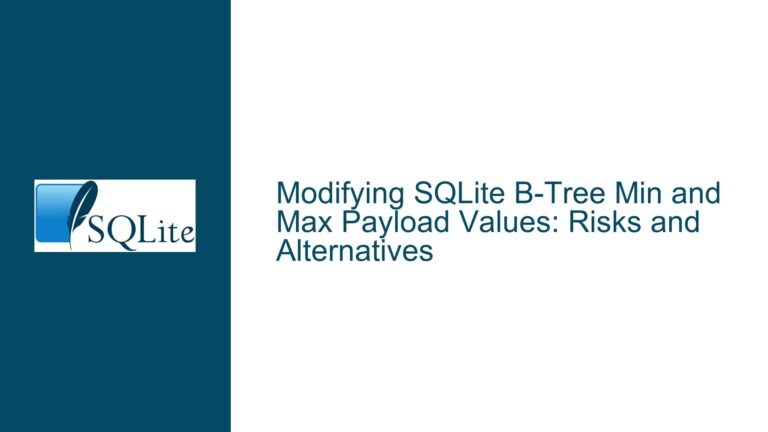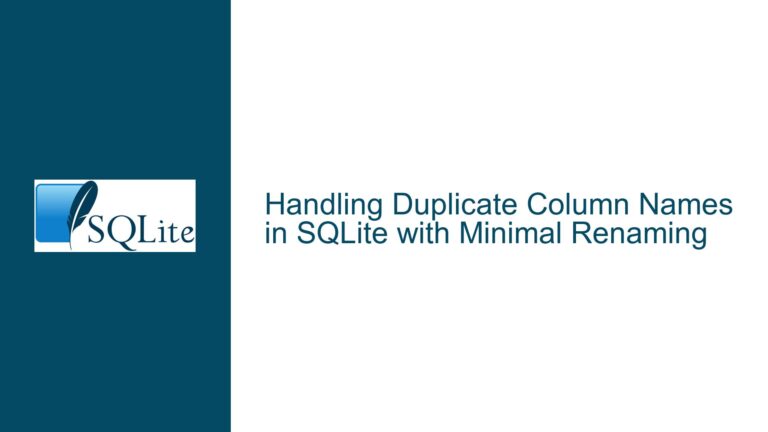Database Header Text Encoding Field Value Zero Not Documented in SQLite
Database Header Text Encoding Initialization and Documentation Discrepancy
Text Encoding Field Behavior During Database Initialization and First Use
The core issue revolves around the text encoding field in SQLite database headers displaying a value of zero (0) when inspected immediately after database creation or schema modifications that do not involve text operations. This contradicts official SQLite documentation which states that valid text encoding values are 1 (UTF-8), 2 (UTF-16le), 3 (UTF-16be), and explicitly asserts "no other values are allowed." The discrepancy arises because the text encoding field remains uninitialized (value 0) until the first text-based operation occurs, such as creating a table with a text column or inserting string data. This uninitialized state is not accounted for in the documentation, leading to confusion when developers inspect the database header directly or use tools like the SQLite shell’s .dbinfo command.
The text encoding field’s delayed initialization is an intentional design choice to optimize database creation. SQLite defers committing to a specific text encoding until the first operation requiring text storage occurs. Until then, the encoding field remains at zero, even if the PRAGMA encoding command is executed. This behavior ensures that databases without text data avoid unnecessary metadata commitments, but it creates inconsistency with the documented specifications.
The problem is observable through direct inspection of the database header or using SQLite shell commands. For example, creating a new database and setting user_version does not initialize the text encoding field. Subsequent operations involving text (e.g., table creation with a TEXT column) trigger the encoding field to adopt a valid value based on the active encoding setting. This lag between database creation and encoding field initialization is the root of the documentation gap.
Delayed Initialization Logic and Encoding Pragmas
The text encoding field’s value is determined by the first operation that requires SQLite to persist text data. When a new database is created, SQLite initializes the header with default values, leaving the text encoding field as zero. The PRAGMA encoding command does not directly modify the header but instead sets an internal flag that will influence the encoding value once it is finalized. For instance, executing PRAGMA encoding = "UTF-16le"; configures SQLite to use UTF-16le for subsequent text operations but does not update the header until text is actually stored.
This design minimizes write operations during database setup. If a developer creates a database but never stores text data, the encoding field remains zero indefinitely. However, most real-world databases eventually store text, forcing SQLite to resolve the encoding. The resolution process involves writing the chosen encoding value (1, 2, or 3) to the header. Until this occurs, tools like .dbinfo or direct byte-level inspection will report the encoding field as zero, conflicting with the documentation.
The confusion is exacerbated by the fact that PRAGMA encoding; returns the currently active encoding (e.g., UTF-8) even when the header field is zero. This output reflects SQLite’s runtime configuration, not the persisted header state. Developers may mistakenly assume the header has been updated after executing the pragma, but the header remains unmodified until text operations force a write.
Implications for Cross-Version Compatibility and Tooling
The undocumented zero value poses risks for tools or scripts that parse the database header directly. For example, database validation utilities might erroneously flag databases with a zero encoding field as corrupt, even though SQLite itself handles the value correctly. Similarly, developers writing cross-platform database migration tools could misinterpret the encoding if they rely solely on the header field without accounting for its delayed initialization.
Furthermore, the documentation’s omission of the zero value creates ambiguity in edge cases. Suppose a database is created, configured to use UTF-16 via PRAGMA encoding, but never used to store text. The header’s encoding field remains zero, and if the database is later attached to another SQLite instance, the effective encoding defaults to UTF-8 (SQLite’s default) unless overridden. This could lead to data corruption if the second instance assumes UTF-8 while the original intent was UTF-16.
Technical Roots of the Text Encoding Field’s Uninitialized State
Header Field Initialization Deferred Until First Text Operation
SQLite’s file format specification reserves the first 100 bytes of the database file for the header. The text encoding field is located at byte offset 56 and is 4 bytes long. During database creation, SQLite writes default values to most header fields but leaves the text encoding field as zero. This field is only updated when SQLite needs to write text data to the database, such as creating a table with a TEXT column, inserting string literals, or defining collations.
The deferred initialization optimizes performance for databases that do not require text storage. Writing the encoding value prematurely would incur unnecessary I/O overhead. However, this optimization is not reflected in the documentation, leading developers to expect the field to always hold 1, 2, or 3.
Interaction Between Encoding Pragmas and Lazy Initialization
The PRAGMA encoding command influences SQLite’s internal state but does not directly modify the database header. When executed, it sets a flag in the database connection object indicating the desired text encoding. This flag is used to determine the encoding when the first text operation occurs. For example, if PRAGMA encoding = "UTF-16le"; is called before creating a table, the encoding field will be set to 2 once the table is created.
If no PRAGMA encoding is issued, SQLite defaults to UTF-8. However, this default is not written to the header until text operations occur. Developers inspecting the header before this point will see a zero, creating the illusion of an undocumented state.
Misalignment Between Runtime Configuration and Persisted State
SQLite’s architecture separates runtime configuration from persisted database state. The PRAGMA encoding command affects the former but not the latter until necessary. This separation ensures that databases remain portable; the encoding is only persisted when needed, avoiding assumptions about the environment in which the database might be used. However, this separation is not clearly explained in the documentation, leading to expectations that runtime configuration changes immediately affect the persisted state.
Resolving Encoding Field Ambiguities and Documentation Updates
Step 1: Validating the Encoding Field State
To diagnose whether a database’s text encoding field is uninitialized (0) or set (1, 2, 3), use the SQLite shell’s .dbinfo command or inspect the header directly.
Using
.dbinfo:
Open the database in the SQLite shell and execute.dbinfo. Look for thetext encodingline. A value of 0 indicates the encoding has not been finalized.Direct Header Inspection:
Use a hex editor or a tool likexxdto view the first 100 bytes of the database file. The text encoding field is at offset 56 (0x38 in hex). A value of00 00 00 00(little-endian) corresponds to 0.Cross-Check with
PRAGMA encoding:
ExecutePRAGMA encoding;to see the runtime encoding configuration. Note that this may differ from the persisted header value until text operations occur.
Step 2: Forcing Encoding Field Initialization
To ensure the encoding field is set, perform a text operation:
Create a Table with a Text Column:
CREATE TABLE dummy (dummy_text TEXT);This forces SQLite to finalize the encoding and write it to the header.
Insert a Text Value:
INSERT INTO dummy VALUES ('force encoding');Even empty strings or single-character values will trigger initialization.
Define a Collation Sequence:
CREATE COLLATION dummy_collation COMPARE ...;Collations involve text processing and may initialize the encoding field.
After performing any of these operations, recheck the encoding field with .dbinfo or direct inspection to confirm it now holds 1, 2, or 3.
Step 3: Updating Documentation and Development Practices
Documentation Revisions:
The SQLite documentation should be updated to acknowledge the zero value as a valid initial state. Suggested phrasing:A value of 0 indicates the encoding has not been determined. This occurs in newly created databases until the first text operation. Once set, valid values are 1 (UTF-8), 2 (UTF-16le), or 3 (UTF-16be). No other values are allowed.
Developer Guidance:
- Always assume the encoding field may be zero until text operations occur.
- Use
PRAGMA encodingto set the desired encoding early, but follow it with a no-op text operation (e.g., creating a temporary table) to force header initialization. - Validate encoding fields in tooling by handling zero as a transient state rather than an error.
Tooling Adjustments:
- Database validation tools should treat a zero encoding field as valid unless accompanied by text data (checked via
sqlite_masterentries). - Migration scripts should explicitly set the encoding via
PRAGMA encodingand perform a text operation before transferring data.
- Database validation tools should treat a zero encoding field as valid unless accompanied by text data (checked via
By addressing the documentation gap and aligning developer practices with SQLite’s lazy initialization logic, the risks of misinterpretation and data corruption can be mitigated.






